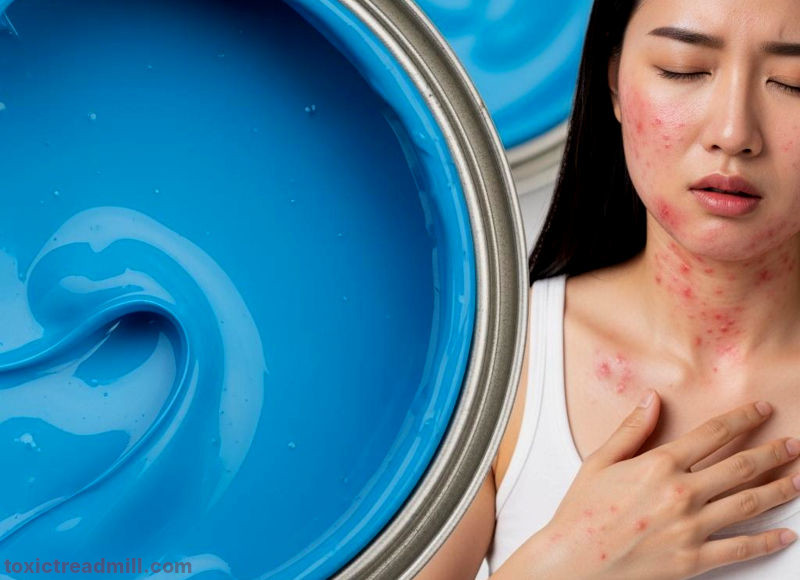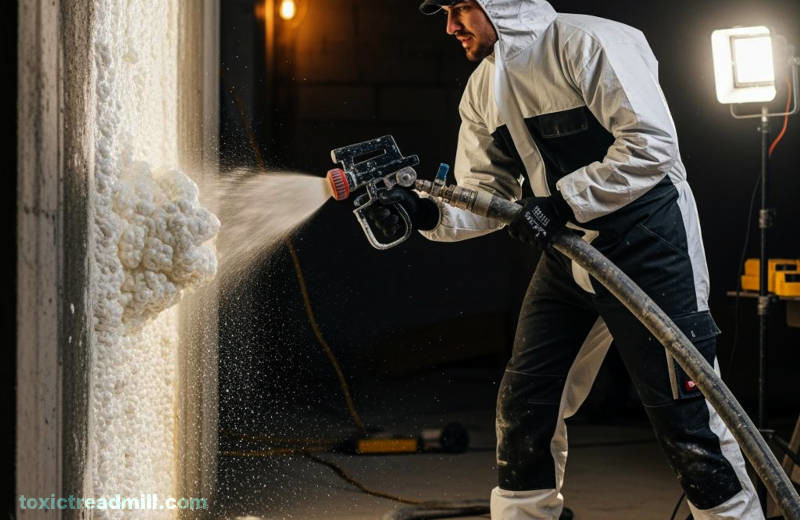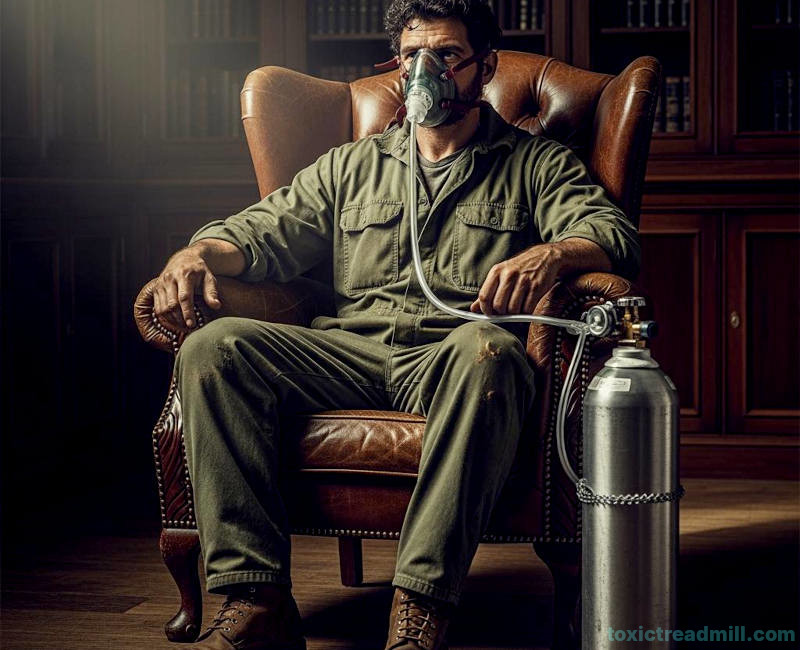Toxic Treadmill
Evidence for a Poisoned Planet
The Harmful Ingredients in Your DIY Products
DIY products are widely used by consumers and professionals alike for construction and home improvement projects. However, a multitude of these products contain chemicals and toxicants that can result in a range of adverse health effects. Among the chemicals of concern are volatile organic compounds (VOCs), formaldehyde and formaldehyde-releasing resins, isocyanates, phthalates, solvents, heavy metals, and various preservatives and biocides. When present in products such as paint, varnish, glue, sealant, MDF, insulation, plasterboard, and cement, these substances pose risks that range from acute irritation, allergic contact dermatitis, and respiratory sensitization to long-term chronic conditions including cancer, neurotoxicity, reproductive toxicity, and chronic respiratory disease.
Harmful Ingredients in Paints, Varnishes, and Solvent-Based Products
Solvent-Based Paint Removers and Varnish Components
Historically, paint and varnish formulations have contained highly toxic organic solvents. Solvent-based removers often incorporate chemicals such as methylene chloride (dichloromethane, DCM) and N-methylpyrrolidone (NMP), which present severe human health risks. Methylene chloride is metabolized to carbon monoxide and formaldehyde in the liver, contributing to acute neurotoxicity, respiratory effects, and an increased risk of cancer—a risk that ultimately precipitated its ban for consumer use in many regions. NMP, while an alternative to methylene chloride, shows high dermal absorption potential and is associated with reproductive and developmental toxicity including male infertility and fetal harm. Moreover, paint removers may contain toluene, a volatile organic solvent that contributes to central nervous system depression, respiratory irritation, and potential long-term organ damage.

In addition to these solvents, paint formulations include VOCs such as benzene, toluene, ethylbenzene, and xylene. VOCs in paint contribute to acute irritation of the eyes, nose, and throat, and to chronic health problems like respiratory disease, liver and kidney damage, and a dose-dependent increase in cancer risk. The off-gassing of these compounds—whether from current formulations or legacy materials—means these substances will continue to contribute to indoor air pollution and attendant chronic health risks long after they have been applied.
Allergens and Preservatives in Water-Based Paints
Modern water-based paints, although lower in some toxic agents such as lead (a legacy contaminant in oil-based paints), now incorporate a variety of biocides and preservatives to inhibit microbial growth. Prominent among these compounds are isothiazolinones, including methylisothiazolinone (MI), methylchloroisothiazolinone (MCI), octylisothiazolinone (OIT), benzisothiazolinone (BIT), and butylbenzisothiazolinone (BBIT). These preservatives are highly volatile and are known major allergens capable of causing allergic contact dermatitis, including airborne allergic contact dermatitis that may affect non-occupational settings such as residential dwellings. Although regulations have been proposed and, in some jurisdictions, implemented to restrict their usage in consumer paints, the persistence of these compounds in legacy products, combined with continued usage in some new products, means that exposure remains common and problematic.
Epoxy Resins and Isocyanates in Industrial and DIY Paints
Another significant group of chemicals in finishes includes synthetic resins, particularly epoxy resins and isocyanates. Epoxy resins, such as diglycidyl ether of bisphenol A resin (DGEBA-R) and diglycidyl ether of bisphenol F resin (DGEBA-F), are prominent allergens in both industrial and DIY coatings. They contribute to occupational allergic contact dermatitis, with airborne exposure causing non-contact sensitization in conditions where off-gassing occurs. Isocyanates, including aromatic variants like toluene diisocyanate (TDI) and diphenylmethane diisocyanate (MDI) as well as aliphatic isocyanates (e.g., hexamethylene diisocyanate, HDI), are used as curing agents in polyurethane paints and varnishes and are well documented to cause respiratory sensitization, occupational asthma, and contact dermatitis. Their high reactivity and volatility ensure that even low-level exposure over extended periods may result in chronic respiratory conditions and, in some cases, irreversible lung damage.
These chemicals, whether found in current formulations or remaining in off-gassing legacy products, present significant long-term health hazards. Off-gassing leads to chronic exposure even after application, and studies from both occupational and environmental contexts have linked such exposure to increased cancer risk and systemic toxicities.

Harmful Components in Adhesives, Glues, and Sealants
Epoxy Resins and Acrylate Compounds in Adhesives
Adhesives and glues used in DIY projects, such as those for woodworking or general repairs, often contain epoxy resins and acrylate compounds that are known sensitizers. Epoxy resins such as DGEBA-R are coupled with hardeners that may include polyfunctional aziridine compounds or 1,3-benzenedimethanamine derivatives, which are potent inducers of allergic contact dermatitis. Acrylates—including methyl methacrylate, ethyl acrylate, and butyl acrylate—are routinely used in plastic adhesives and glues. These compounds can cause both irritation and sensitization of the skin, and inhaled vapors can trigger occupational asthma, with some reports indicating that even transient levels may induce chronic allergic reactions.
Formaldehyde-Based Resins in Wood Adhesives
In the production of composite wood products such as MDF and plywood, adhesives based on formaldehyde-releasing resins (e.g., melamine-formaldehyde and urea-formaldehyde resins) play a crucial role. These adhesives have been associated with the off-gassing of formaldehyde—a known human carcinogen—and have been linked to respiratory irritation, allergic contact dermatitis, and long-term cancer risks. The persistence of formaldehyde emissions from these products is particularly concerning, as once incorporated into building materials such as MDF, the chemical continues to off-gas over many years, thereby exposing occupants to chronic low-level toxicity.
Isothiazolinone Preservatives in Water-Based Adhesives and Sealants
Similar to their use in paints, isothiazolinone biocides are also prevalent in adhesives and sealants. Their volatility and propensity to become airborne contribute to a substantial risk of allergic reactions and dermatitis. The combination of these preservatives with other toxic solvents in adhesives can exacerbate the overall toxic burden. Prolonged exposure is linked to persistent allergic contact dermatitis and has been suggested to potentially contribute to more systemic health outcomes given the cumulative exposure profile in occupational scenarios.
Toxins in Composite Wood Products (MDF, Plywood) and Off-Gassing Concerns
Composite wood products such as MDF and particleboard rely heavily on adhesives that release formaldehyde, with resultant off-gassing representing a significant source of indoor pollution. Formaldehyde exposure has been associated with multiple respiratory and carcinogenic effects and is recognized as a chronic irritant to the mucous membranes. Furthermore, these products may also be treated with additional chemicals such as fire retardants, which in some cases are linked to allergic contact dermatitis and respiratory sensitization. The continuous off-gassing from legacy MDF products containing formaldehyde-based resins remains a public health concern, particularly in indoor environments where ventilation is inadequate.
Health Problems Caused by Insulating Materials
Polyurethane Foams and Isocyanate Exposure
Insulation products, particularly spray polyurethane foam (SPF), are notable for the presence of isocyanates, including methylene diphenyl diisocyanate (MDI) and toluene diisocyanate (TDI). These chemicals are recognized as respiratory sensitizers that can lead to occupational asthma and other chronic respiratory conditions. Even low-level airborne exposure during the application of SPF insulation has been measured at levels significantly above occupational exposure limits in some cases, presenting a clear risk for both acute and chronic respiratory issues.
Flame Retardants, Catalysts, and Residual Emissions in Insulation
In addition to isocyanates, polyurethane foams and other insulation products contain flame retardants (e.g., TCPP, TCEP, TDCPP) and amine catalysts which have been linked to endocrine disruption, reproductive toxicity, and potential neurotoxicity. Tin-based catalysts, such as dibutyltin dilaurate (DBTDL), contribute further to the respiratory and dermatologic irritation upon exposure. The degradation of these materials over time results in continued off-gassing, thereby extending the exposure period well beyond the initial application.

Other VOC Emissions from Insulation and Their Systemic Effects
In many insulation materials, the emissions of VOCs—ranging from styrene and toluene to aliphatic hydrocarbons—have been associated with headaches, neurotoxicity, and respiratory toxicity. The study of VOC emissions from thermal insulation materials indicates that these exposures can lead to both immediate irritant symptoms and longer-term systemic toxicities, including potential carcinogenic effects. The persistence of such emissions from both modern and legacy insulation materials underscores the importance of proper application techniques and adequate ventilation to reduce indoor exposure.
Chemical Hazards in Plasterboard and Cement
Cement-Related Toxins and Chromate Compounds
Cement used in construction contains chromates and other heavy metals, such as cobalt and nickel, which are added for their anti-corrosive properties. These metal compounds are recognized for their irritant and allergenic potential, often leading to occupational contact dermatitis, particularly on the hands, elbows, and knees. Despite reformulations (e.g., the addition of ferrous sulfate to mitigate chromate exposure), chromate-induced allergic reactions remain a risk for construction workers and DIY enthusiasts handling cement.
Particulate Matter and Off-Gassing in Plasterboard
Plasterboard production involves a range of binders, and during application or when disturbed, these materials can release particulate matter combined with residual VOCs. Such exposures can cause respiratory irritation and, over extended periods, have been associated with chronic respiratory conditions. In addition, some formulations may include formaldehyde or organic solvents as part of surface finishes, thereby compounding the chronic toxicity risk associated with indoor exposure.
Heavy Metals and Carcinogenic Risks
Both cement and plasterboard sometimes contain residual heavy metals, including lead, cadmium, and mercury, either as contaminants or as functional additives. Inhalation or dermal exposure to these metals is known to contribute to neurotoxicity, kidney damage, and an elevated risk of cancer. The cumulative exposure from these materials, especially in inadequately ventilated indoor environments, reinforces their role as chronic hazards.
Secondary Exposures from Sandpaper and Dust-Generating Materials
While sandpaper is primarily a mechanical abrasive tool, the chemical risks associated with sandpaper typically originate from dust particles generated during sanding processes, which may include residues from coatings or adhesives previously applied. For instance, sanding materials such as paint-coated surfaces or MDF can release airborne particulate matter that carries organic chemicals, epoxy resin fragments, and formaldehyde. Inhalation of such dust may contribute to respiratory irritation, allergic contact dermatitis, and, in the long term, chronic respiratory conditions. Although the individual contribution from sandpaper itself is less direct, the secondary exposure via dust in DIY practices remains a significant route for chemical uptake.
Cumulative and Chronic Health Effects
Respiratory and Systemic Toxicity
There are multiple modes for exposure to the hazardous chemicals in DIY products including inhalation, dermal contact, and, in some cases, ingestion. VOCs, isocyanates, and solvents are consistently implicated in causing respiratory diseases such as occupational asthma, chronic obstructive pulmonary disease (COPD), and hypersensitivity pneumonitis. Additionally, heavy metals present in cement and paint pigments further contribute to systemic toxicity, manifesting neurotoxicity and renal impairment. Studies from occupational settings have demonstrated dose-response relationships between certain chemical exposures, such as methylene chloride and isocyanates, and the development of long-term pulmonary and systemic conditions.
Carcinogenic Risks and Terminal Health Outcomes
A number of the chemicals discussed are classified by regulatory agencies as human or probable carcinogens. For instance, formaldehyde—a primary concern in MDF off-gassing from formaldehyde-based resins—is a well-documented carcinogen associated with nasopharyngeal cancers and other malignancies. VOCs such as benzene, ethylbenzene, and certain halocarbons found in paints and coatings have also been strongly linked to elevated cancer risks. Legacy chemicals, including lead from oil-based paints and pentachlorophenol used in wood preservatives, further exacerbate these risks as they continue to be present in older materials and continue to off-gas into indoor environments. The continued presence of such substances in both current formulations and as remnants in older buildings suggests that chronic exposure may lead not only to cancer, but also to terminal systemic effects in susceptible individuals.
Allergic Contact Dermatitis and Respiratory Sensitization
An important subset of the toxic chemicals in DIY products are those that induce allergic contact dermatitis and respiratory sensitization. Isothiazolinones in paints and adhesives, epoxy resins, and formaldehyde-based adhesives are leading causes of occupational allergic reactions, with numerous cases documented in populations exposed during application processes. The airborne nature of many of these sensitizers increases risk not only among direct users but also among bystanders in both occupational and domestic settings. Chronic allergic contact dermatitis can lead to permanent skin sensitization and reduced quality of life, while respiratory sensitization may predispose individuals to long-term asthma and other airways diseases.
Reproductive and Developmental Toxicity
Several solvents and chemical additives, most notably NMP and some phthalates found in adhesives and sealants, have been linked to reproductive and developmental toxicity. Animal studies and human case reports provide evidence that exposure to NMP can lead to adverse reproductive outcomes such as male infertility and fetal developmental harm. Although regulatory measures have limited the use of some of these chemicals in certain applications, the legacy products and continued industrial usage still pose significant risks to the reproductive health of exposed populations.
Summary
The toxicological landscape for common DIY products is complex and multifaceted. Paints, varnishes, glues, sealants, MDF, insulation, plasterboard, and cement all incorporate multiple harmful ingredients either as functional components or as byproducts during manufacturing, application, or degradation. Insulation materials, particularly spray polyurethane foams, release significant amounts of isocyanates and flame retardants that carry both respiratory and systemic toxicity risks. Cement and plasterboard, with their content of chromates and residual heavy metals, further contribute to respiratory and dermal hazards. The presence of volatile organic compounds contributes to indoor air pollution and chronic respiratory risk, while formaldehyde and its releasers in MDF and adhesives represent a dual threat of igniting allergic reactions and increasing carcinogenic risk. Isocyanates and epoxy resin components, widely used in coatings and adhesives, are prominent inducers of respiratory sensitization and allergic contact dermatitis, conditions that can become chronic and functionally debilitating over time.

In addition, many of the chemicals remain problematic not only because of their immediate effects during application but also because of off-gassing from legacy formulations. For example, older MDF panels and insulation materials may continuously release formaldehyde or isocyanates over many years after installation, thereby extending exposure well beyond the construction phase. Similarly, solvents in paint removers and varnish strippers may persist on surfaces or in indoor air long after the product is applied, leading to cumulative exposure in residential and occupational settings.
Exposure pathways are diverse, including inhalation of volatile compounds, dermal absorption during application, and even ingestion of dust containing chemical residues. Such diversity complicates efforts to pinpoint individual risk factors, as combined exposures may lead to additive or even synergistic adverse health effects. Epidemiological evidence and occupational studies repeatedly confirm associations between these chemical exposures and chronic respiratory diseases, cancers, neurological impairments, and reproductive disorders. Even low-level chronic exposure may cumulatively result in irreversible health outcomes. Product ingredients are regularly reviewed and, once substantial evidence of harm is discovered, they may eventually be removed from the market. However, this process is typically slow, and inevitably involves causing lasting harm. Additionally, industry often replaces harmful chemicals with new ones that, if tested at all, pass minimal, short-term evaluation, and will likely pose similar or new hazards to the ones they replace.
References
Durrani, T., Clapp, R., Harrison, R., & Shusterman, D. (2020). Solvent‐based paint and varnish removers: a focused toxicologic review of existing and alternative constituents. Journal of Applied Toxicology, 40(10), 1325-1341.
Ghobakhloo, S., Khoshakhlagh, A. H., Morais, S., & Mazaheri Tehrani, A. (2023). Exposure to volatile organic compounds in paint production plants: levels and potential human health risks. Toxics, 11(2), 111.
Law, R. M., & Maibach, H. I. (2019). Paints, lacquers, and varnishes in occupational dermatology. In Kanerva’s Occupational Dermatology (pp. 919-937). Cham: Springer International Publishing.
Lin, C. H., Lai, C. H., Peng, Y. P., Wu, P. C., Chuang, K. Y., Yen, T. Y., & Xiang, Y. K. (2019). Comparative health risk of inhaled exposure to organic solvents, toxic metals, and hexavalent chromium from the use of spray paints in Taiwan. Environmental Science and Pollution Research, 26, 33906-33916.
Lukács, J., Präßler, J., Gebhardt, M., & Elsner, P. (2020). Adhesives and glues. Kanerva’s Occupational Dermatology, 891-900.
Mo, Z., Lu, S., & Shao, M. (2021). Volatile organic compound (VOC) emissions and health risk assessment in paint and coatings industry in the Yangtze River Delta, China. Environmental Pollution, 269, 115740.
Naldzhiev, D., Mumovic, D., & Strlic, M. (2020). Polyurethane insulation and household products–a systematic review of their impact on indoor environmental quality. Building and Environment, 169, 106559.
Velichko, E., Tskhovrebov, E., & Shevchenko, A. (2017). Environmental safety providing during heat insulation works and using thermal insulation materials. In MATEC Web of Conferences (Vol. 106, p. 03009). EDP Sciences.
Wi, S., Park, J. H., Kim, Y. U., & Kim, S. (2021). Evaluation of environmental impact on the formaldehyde emission and flame-retardant performance of thermal insulation materials. Journal of Hazardous Materials, 402, 123463.